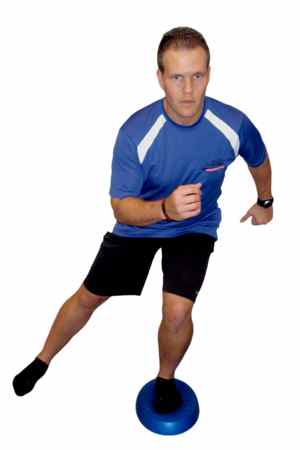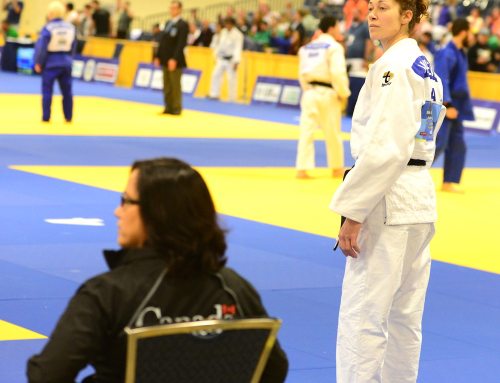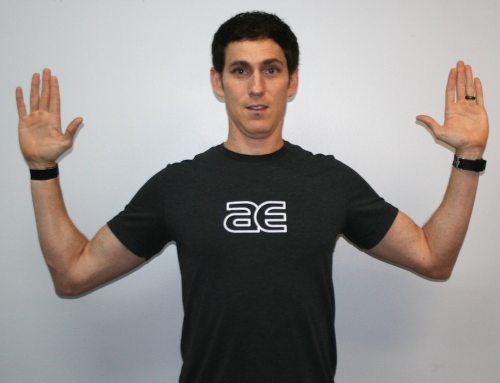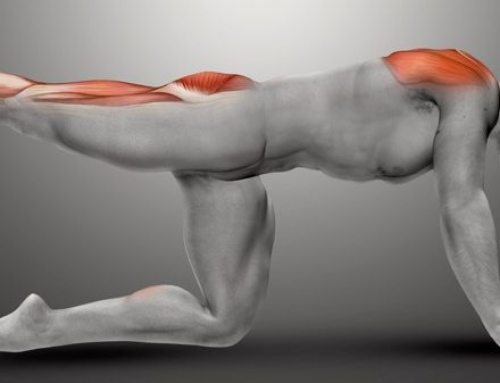Training for Balanced Running
By Brian Schiff, PT, CSCS
For most runners, balance may not be something that comes to mind when training for performance. They are often more focused on speed, strength, power, and endurance. However, single-limb balance and stability is a key component for injury prevention and proper mechanics.
If you consider the increasing popularity of minimalist shoes and barefoot running, you may think differently about balance in the kinetic chain as it relates to running performance and ground reaction forces on the body. For example, consider some basic truths about running:
- The body is in single-limb support at all times
- The “flat ground” courses always have slopes from right to left (or vice-versa)
- There are always turns on the course
- Some courses are off-road or feature grass or trails
- The potential for being bumped or knocked off balance exists in a pack
With these things in mind, assessing single-leg balance and training it preventively is a good strategy. This becomes even more important for trail runners and those now entering Mud Runs and Warrior Challenges. That being said, there is a logical progression to how you approach these exercises.
Based on the fact that there are runners with varying degrees of innate balance, different medical histories (prior ankle sprains are always a concern), multiple running styles and different shoes, I am going to focus on training without footwear. Shoes tend to give added support during balance tasks. Therefore, training without them will increase the difficulty of the activity, but will yield greater activation of the intrinsic muscles of the foot and the entire lower leg.
Keep in mind that motion at the ankle directly affects knee and hip mechanics. Therefore, minimizing pronation and maintaining a neutral arch is ideal. Disruptions in foot/ankle position during training and racing happen, and they will have a direct effect on how ground reaction forces are transferred up through the entire leg. Adding this type of training two to three days per week will often improve lower-limb alignment/stability and running mechanics, thereby maximizing gait efficiency and reducing the risk for running-related overuse injuries.

The following exercise progression consists of four simple yet effective ones I advise runners to consider to improve balance and proprioception. Please note I am using a blue theraband foam pad, but a folded pillow is an easy option to try at home. If you are unable to maintain proper alignment on a pad, begin the entire sequence on the floor prior to adding an unstable surface beneath the foot.
- Static single leg balance – Position the foot in the center of the pad and hold for 30 to 60 seconds, keeping a slightly bent knee (25 to 30 degrees of knee bend). Perform one to two sets and progress to eyes closed if this becomes easy.
- Static split squat holds – Position the body in a lunge position (arms and legs are opposite as in running) and hold for 30 seconds. Repeat twice on each leg. Again, the arch should remain neutral and the knee should be in line over the second toe.
- Dynamic hip drive holds – Balance on one leg as described in the static single leg balance and then bring the opposite leg up and hold for five seconds. Next, allow the free leg to drop down and back (but not touching the ground) while maintaining balance on the stance leg. Pause, and then raise it up again and hold in the drive position. Repeat 10 times on each side and perform one to two sets.
- Dynamic side reaches – Begin in the static single leg balance position and then slowly reach the other leg directly to the side and away from the midline of the body. The goal is to maintain a neutral arch and prevent the stance ankle, knee, and hip from collapsing toward the inside. Pause at the farthest point where balance is maintained and return to the upright position. Perform one to two sets of 10 reps on each side.
# # #
Brian Schiff, PT, CSCS, is a sports physical therapist and supervisor at The Athletic Performance Center in Raleigh. For more information on their services, visit the APC online at www.apcraleigh.com or www.apccary.com.





